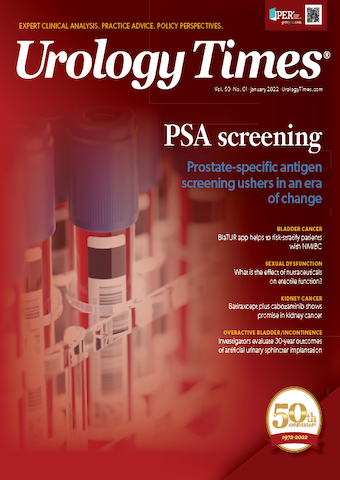Publication
Article
Urology Times Journal
BlaTUR app helps to risk stratify patients with NMIBC
Author(s):
"At the end of the day, the idea is that it shows you what your next steps are based on what the AUA and SUO guidelines are for non–muscle invasive bladder cancer," says Chad R. Ritch, MD, MBA, FACS.
Risk stratification has always been an issue in the world of bladder cancer and one that continues to be studied so that urologists can practice better. Although there has been a huge acknowledgement of the overtreatment and undertreatment of patients, there still isn’t a clear solution.
Chad R. Ritch, MD

BlaTUR is a free app that was co-created in 2021 by Chad R. Ritch, MD, MBA, FACS, and Jonathan E. Katz, MD, in an effort to help clinicians manage and risk stratify patients with bladder cancer. By answering a short questionnaire about a patient’s disease, both clinicians and patients can learn what treatments are recommended by the American Urological Association’s (AUA) guidelines in a short amount of time. Ritch is an associate professor of urology and associate director of UHealth International, and Katz is a PGY5 resident at the Miller School of Medicine, University of Miami, Florida.
Please describe the process of creating this app.
Katz: Basically, when we took a look at the [AUA] guidelines, there's a very nice algorithm [where] if you go stepwise through it, you [can] map out at each stage what the next step would be based on the risk factors of a given patient. We went through, between the algorithm and the actual guidelines on the AUA non–muscle-invasive bladder cancer webpage, stepwise, what happens if a patient is this? And then, what would the algorithm or our version, the application, display for the end user?
Ritch: One of the things that Dr Katz has been very humble about is the fact that the process for designing the app actually took quite a few months. It's a very iterative process. So, although the algorithm is very straightforward and it shows you [the next step] if you have 1 particular risk group, mapping all these things into a real-time app that you can change and revise and go back and forth takes a serious amount of time. Dr Katz was there, back and forth, with my clinical input as a guideline panel member showing him for each step what the next procedure would be. And then, we kept on constantly testing it to make sure that it made sense. So, [for] each version, we found a little kink, we would fix it, and then go back and forth. He was really pretty much a genius when it came to coding and getting this in app form.
How does the app work?
Katz: Anyone can go on to the application and put in patient information, and it will, based on the current guidelines from the AUA, give you the risk stratification and what the next step in treatment and surveillance would be for each patient.
Ritch: The general idea is if you're in clinic and you have this app downloaded on your phone—because you can put a shortcut on your phone—instead of having to go online, find the guideline, and see where you are, you can actually take this app, click on it, and open it up. You risk stratify patients on there, and then just put in the clinical parameters, the grade, the stage of the non–muscle-invasive bladder cancer, and then it will tell you what the next steps are. So, it's meant to be very user friendly. It's not a replacement for clinical judgment, obviously. But at the end of the day, the idea is that it shows you what your next steps are based on what the AUA and [Society of Urologic Oncology (SUO)] guidelines are for non-muscle invasive bladder cancer.
Why should urologists who treat bladder cancer know about and download this app?
Ritch: I think what it comes down to is user friendliness. The idea is that instead of having to look at several pages of guidelines or running through texts and trying to find it, it's user friendly. You go, again, straight to your phone or to a website. The website is www.blaTUR.com. Then, you access it and you can just put in the clinical parameters, and it will give you the next step in management pretty quickly. Any urologist who's treating bladder cancer who needs quick access to the guidelines but doesn't want to go through reading all the different things, they can download this app and use it right there in clinic.
What do you think this app says about the future of health care in terms of becoming more mobile friendly and accessible to users?
Katz: I think a couple things. One: when coming up with guidelines, it is helpful to immediately, when a panel makes a set of guidelines, develop an interface for people to interact with those guidelines, sort of the way MDCalc has done that for many things. But some guidelines are more complicated than just putting it into a medical calculator online, and I think people should pay attention to that. Building on that, the next step really is to be able to collect data like this and to try to use AI in the future to predict treatment responses and to potentially better risk stratify patients using some of the data that is collected. I want to be clear. We're not collecting any data. We're not doing any of that, but in the future, I do think that will be possible and beneficial for patients.
Ritch: I agree. To follow-up on that, 1 of the key things here is [that] in medicine we are so reliant on electronic medical records [EMRs] and an integration with this. Things like an app for guidelines can be easily integrated into an EMR; for example, Epic. If you want to know what the next steps are, and let's say it was integrated into this app—in particular, you have a non–muscle-invasive bladder cancer patient—if you had a link in your Epic, you could go ahead and use it, and then copy and paste the care plan from that app. Something like that will be the future. And I think there's a lot of ways that you can integrate medical apps into the EMR for use that will help to improve management and make us more efficient.
Is there anything else you feel urologist should know about this app?
Ritch: Well, I think 1 of the first things you already should know about the app is that it is based on the AUA and SUO guidelines for the management of non–muscle-invasive bladder cancer. It is not a replacement for the guidelines, and it's not a replacement for clinical judgment. We're basically just putting this into a user-friendly format. The second thing is that it's free online, so there's no cost to you to download or use the app. The third thing is [that] we came up with this name better blaTUR, which is a play on words. It's both bladder and the TUR, which is the procedure used to diagnose and treat bladder cancer—transurethral resection. That URL, www.blaTUR.com, is where you'll find the app and you can pronounce it either way, bladder or blaTUR.
Try out the NMIBC navigator at www.blaTUR.com.

































